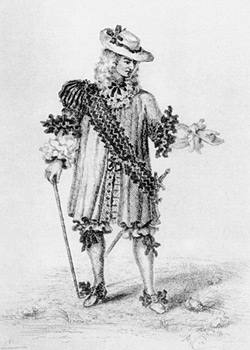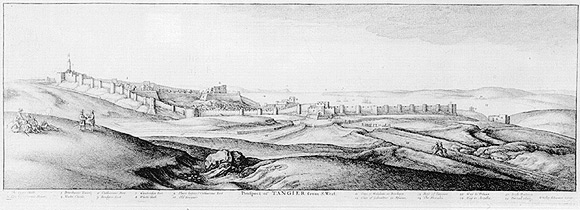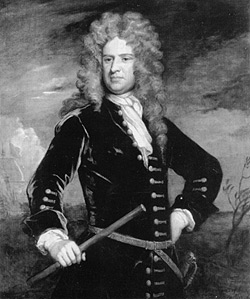Colonel Sir Palmes Fairborne
1635-1680 and Admiral of the Fleet
Sir Stafford Fairborne 1666 - 1774
The Queen's Royal Regiment were always justly proud of Colonel Sir Palmes Fairborne who served and died heroically in the defence of Tangier during the 17th Century British occupation. He was the first of many distinguished Officers of the Regiment who achieved his advancement by his military skill, thoroughness and attention to detail and by his natural aptitude for command and leadership. At the former Depot in Stoughton Barracks, Guildford his name is permanently commemorated by one of the roads within the newly developed Cardwell's Keep.
The purpose of this article is also to write about Sir Palmes eldest son Stafford, who started his service career at Tangier with his father in the Governor's (or old Tangier) Regiment. After five years as a subaltern and the withdrawal from Tangier he transferred to the Royal Navy. Both father and son have significant entries in the Dictionary of National Biography; but before turning to Stafford Fairborne's remarkable career, which seemed largely unknown to the old Queen's, I wish to reveal as much about their family background as it has been possible to glean.
It would appear that the Fairbornes were a Lancashire family from St Anne's, and Palmes was born in 1635, seven years before the outbreak of the Civil War. His father Colonel Stafford Fairborne was a Royalist commander at Newark on Trent which was for long a fiercely contested strategic crossing on the Great North Road. The "Queen's Sconce", (named after Charles I's consort Henrietta Maria) a large earthwork for mounting cannon, is still to be seen there.
On 30th January 1649 King Charles I was beheaded in Whitehall, and the Royalist cause at its lowest ebb with its defeated supporters dispersed, demoralised and financially ruined. It may explain why young 16 years old Palmes spent the year of 1651 fighting as a mercenary for the Venetians against the Turks besieging Candia (Heraklion) in Crete. Apparently Palmes Fairborne greatly valued his first experience of active service; years later when he was granted a coat of arms it featured a Turk's head impaled on a sword, with a Latin inscription "Learning is Strength".
The next time Palmes Fairborne comes to notice is on 14th October 1661 as a Captain commanding a company at Lord Peterborough's initial muster of the "Tangiers" Regiment on Putney Heath before it sailed from Deal to become part of the garrison. It seems likely that prior to his formal commissioning he had met and married his wife Margery who was a young widow. Born Margaret Devereux, she had been briefly married to a Mr Mansell, and proved to be a loyal and supportive wife who accompanied her husband to Tangier.
Altogether she bore him seven children, their eldest Stafford was born in Tangier in 1666; unfortunately the church registers for the Anglican Garrison Church are missing.
Stafford Fairborne was named after his grandfather, the Royalist commander at Newark, and spent his childhood and school years in Tangier overlooking the Straits of Gibraltar, and the famously beautiful view of the Spanish coastline.
 |
| A detailed drawing of Major Palmes Fairbome aged 34 and wearing Full Dress. Made by the distinguished artist Wenceslaus Hollar during a visit to Tangier in 1669, and incorporated by him into a large watercolour in the Print Room of the British Museum. |
During this time his father's career progressed as Palmes was promoted to Major in 1664 in recognition of his outstanding abilities in the first two years of fighting with the Moors, and in 1675 he was knighted. In May 1676, the Earl of Inchiquin, who had been in post as Governor for barely a year, took two years leave of absence and nominated Major Sir Palmes Fairborne joint Deputy Governor with the elderly veteran Colonel Sir Roger Alsop as the other appointee. The latter declined to act on grounds of infirmity, and died later that year. (Interestingly Roger Alsop is referred to in one source as Sir Palmes uncle, so perhaps his mother had been a Miss Alsop before marriage).
During the next two years Sir Palmes, promoted to Lieutenant Colonel in January 1677, acted as Lieutenant Governor with skill, firmness and diligence at a time of extreme financial stringency, when at one time the pay of the garrison was 2 1/2 years in arrears. Sir Palmes and Lady Margery too found it hard going raising their growing family in a house situated between the Head Court of Guard and Catherine Gate, the landward entrance to the City.
The truth was that Tangier had few friends in Parliament prepared to vote the necessary funds. Many Members regarded it as an expensive liability, and/or a nest of "Popery" with its Roman Catholic Cathedral and priests.
In April 1678 the Earl of Inchiquin returned and resumed his Governorship, granting the Fairbornes two years leave of absence. They went home to England for the first time in 16 years and doubtless Sir Palmes and Lady Margery had many things to arrange for their children.
On 1st August 1678, Stafford Fairborne was gazetted an Ensign in Captain St John's Company in the Governor's Regiment, of which his father was the Lieutenant Colonel. He was 12 years of age, and it is difficult to comprehend this 17th century practice of commissioning children either by purchase or by patronage; probably Sir Palmes "fixed" it as he was by no means wealthy.
It also seems highly likely that Samuel Pepys the Treasurer of the Tangier Committee would have met Sir Palmes in London, as they had corresponded frequently in the two preceding years that he had acted as Governor. It is a shame that his eyesight prevented Pepys from keeping his famous diary at this time, as it would be illuminating to have his description and opinion of Sir Palmes. But subsequent events indicate that he made a very favourable impression on those in authority in London.
In April 1680 he returned to Tangier with his wife and children to find it heavily besieged by the Moors and at risk of falling. The weakened garrison was forced to sign a humiliating four months truce which left them holding only three of the fifteen forts outside the City walls, and the Earl of Inchiquin was recalled to London to answer for his ineffectual Governorship. Once again, the newly promoted Colonel Sir Palmes Fairborne was left as the Lieutenant Governor of Tangier. In answer to the urgent despatches from such an experienced and respected soldier recently in England, the government in London responded by despatching large reinforcements, including a composite battalion of Guards, plus warlike stores. The King of Spain sent 200 experienced cavalry who were invaluable in the imminent fighting, as were a battalion of seamen landed from the Fleet.
All the while, Sir Palmes was planning, organising, training and encouraging the troops and shortly before hostilities recommenced he was confirmed as Governor and Commander in Chief. There could have been no better choice.

The Prospect of Tangier from S. West, Drawn by Wenceslaus Hollar in 1669 from a position close to Pole Fort.
On 20th September 1680 Sir Palmes personally led a surprise sortie which recaptured the ruins of Pole Fort and immediately began rebuilding it under strong Moorish counter attacks. There was continuous fighting around Tangier for some weeks prior to a major dawn attack by the whole Garrison on 27th October. But unfortunately three days before, Colonel Sir Palmes Fairborne while reconnoitering, was struck in the body by a musket ball that knocked him from his horse. It was quickly recognised that this was a mortal wound and on 27th October he was carried in a chair to a balcony overlooking the countryside outside the City walls to watch the day's fighting. Not only had Sir Palmes earned the respect of the Moors in all the years he had met them in peace and war, but he also had the trust and confidence of his own troops who felt they were, at last, on an equal footing with their besiegers who numbered about 15,000. Led by Colonel Sackville of the Guards, who was the next senior commander, the British and the Spanish troops fought with skill and enthusiasm, determined to avenge Sir Palmes before his own eyes.
By late afternoon the Moors were defeated and routed from their lines and camps before the dying Governor, who had devoted 18 years of his life to Tangier. He lived long enough to witness his triumphant troops return to the city, but their losses had been heavy with many dead, and over 330 wounded; the ships' Surgeons were landed from the Fleet to help with tending them. On the other hand the Moors' dead were in the order of 2000, and this time it was they who asked for a truce.
It is not clear if 14 year old Ensign Stafford Fairborne took part in the fighting. I think it probable he was left to support his father, and comfort Lady Margery when he died later that night aged only 45.
In official despatches home Sir Palmes was described as ... "a man of undaunted resolution and spirit" .... "of indefatigable diligence" .... " a worthy, able and brave officer". Deeply mourned by everyone at Tangier he was buried in the Anglican Garrison Church, the site of which is now an Islamic Theological College opposite the Grand Mosque. The latter was the Portuguese Roman Catholic Cathedral for nearly 200 years.
The bereaved Lady Margery Fairborne returned to England with her younger children and was awarded a pension of £500 a year for life by King Charles II - but this was irregularly paid after the first year and she had financial difficulties raising her large family of young children. As late as 1703 her eldest son Sir Stafford was petitioning Queen Anne for the arrears of her pension. She erected a monument to her late husband Sir Palmes, with his coat of arms, in the nave of Westminster Abbey.
In 1683 she was married (for the third time) to Jasper Paston a younger son of the first Earl of Yarmouth. This remarkable lady and early example of a "regimental wife" died in June 1694. She is buried in Westminster Abbey.
Admiral of The Fleet Sir Stafford Fairborne 1666 - 1742
After his father's death in October 1680, Ensign Fairborne remained in Tangier with the Governor's (or Old Tangier) Regiment until the withdrawal in the winter of 1683/84 overseen by Lord Dartmouth.
The purser's log shows that he sailed in the "Montague" in March 1684 with Captain St John's Company and disembarked at Falmouth before being stationed in the West country.
In June the Regiment was styled "Our Dearest Consort the Queen's Regiment", but sadly in February 1685 King Charles II died and was succeeded by his controversial brother the Roman Catholic Duke of York who became King James II and who had married, as his second wife, Mary of Modena. The widowed Queen Catherine of Braganza remained in England and her regiment was renamed the Queen Dowager's but retained on its Colours the entwined Cs (as on the famous Third Colour) for Charles and Catherine. At the same time, Trelawny's (or the Second Tangier Regiment raised in 1680) became the Queen Consort's Regiment in honour of the new Queen, Mary of Modena. On their Colours they had a crown above her initials MEBR, standing for Marie Eleanore Beatrice Regina. Suffice to say that this switching of titles has caused endless confusion to military historians ever since!
In March 1685 Stafford Fairborne was promoted to Lieutenant in the newly renamed Queen Dowager's but almost immediately transferred to the Royal Navy in the same rank. Throughout the occupation of Tangier there were always ships in port and crews ashore and it would be interesting to know if the Army officers received formal sea going experience with the Royal Navy. Stafford Fairborne shone from the onset of his career as Lieutenant of the "Bonadventure". Two months later she was part of a naval squadron in the Straits and took part in a successful action with Sallee "rovers" or pirates. Her Captain was ill ashore and Lieutenant Fairborne in command was highly commended for his part; so much so that he was given the Captaincy next year of the "Half Moon", a captured Moorish vessel. He was clearly his father's son, and still only 20.
 |
| An oil painting of Sir Stafford Fairboure by Sir Godfrey Kneller, circa 1703, after he was appointed Vice Admiral of the Red, and aged 37. Formerly in the Royal Collection, it is now at the National Maritime Museum, Greenwich. |
During the next sixteen years he commanded a whole succession of ships, and highlights of this period include the siege of Londonderry in 1689 when he was landed with a naval brigade to attack the shore defences along Lough Foyle which was preventing Major General Percy Kirke's relief of the city by sea. As an experienced foot soldier he would have been a natural choice, and the Queen's were always proud of their links with the Royal Navy, even so it must have been unusual to find 9 Company of his old regiment at the siege of Dundalk later that year, being commanded by Captain Stafford Fairborne RN!
At the Battle of Beachy Head in June 1690 between the Dutch and a combined Anglo French fleet the British C in C was disgraced for not engaging the enemy ships closely enough. An accusation which could not be levelled at Fairborne, because the protective hammocks in the nettings on the upper decks of his ship "Warspite" were found to be full of Dutch musket balls.
In 1695 he commanded the "Victory" with his younger brother William Fairborne as Lieutenant; he is the only one of his six siblings I have been able to trace; and William died in June 1708 in command of the "Centurion" at Leghorn.
In June 1694 he married Dorothy Fane who bore him three sons (who predeceased him) and a daughter, before his wife died in 1707.
In June 1701 Fairborne reached Flag rank when he was promoted Rear Admiral of the Blue and he became Sir ·Stafford in November that year. He held a succession of Rear Admiral appointments until he was promoted to Vice Admiral of the Red in May 1703. Charnock in his "Biographia Navalis" of 17th and early 18th century naval officers devotes a long and detailed account of Sir Stafford Fairbome in the "Association" during the Great Storm of November 1703. It was the worst storm in recorded British history which caused widespread death and destruction ashore and at sea, and altered the coast line at places such as the historic Cinque Port of Rye, which found itself stranded two miles inland.
Briefly, the "Association" was at the Nore when the hurricane from WSW broke her anchor cables in the early hours of 27th November and drove her into dangerous shoals. Some of her ports were breached by the force of the waves and she listed dangerously with the volume of water on her gun decks. Sir Stafford had this let into the bilges by scuppering her decks - it would have to be laboriously hand pumped out later. Righted, but low in the water she was driven by the terrible storms across the North Sea, up the coasts of Holland, Germany and Denmark until she reached Norway. Eventually she managed to limp into Gothenburg in Sweden for essential repairs, out of provisions and with 28 of her crew dead from exposure and exhaustion. Sir Stafford procured new anchors and cables from Copenhagen, provisions and spars from Gothenburg and sailed before she became icebound in the Baltic. The "Association" escorted twelve homebound naval store ships, beat off some French privateers, endured further severe weather and anchored back at the Nore on 23rd January 1704. She had been off station for not quite two months. Sir Stafford Fairbome, and Richard Canning his Captain, were admired and acclaimed for this feat of seamanship.
In 1702 the European conflict known as the War of the Spanish Succession or "Queen Anne's Wars" broke out. While the Duke of Marlborough was fighting and winning his series of great land battles on the continent, the combined fleets of Britain and Holland were at sea. The French and Spanish fleets were out numbered and incapable of fighting a fleet action, but they sent frigates and many privateers to harass and capture our merchantmen on the sea lanes. In turn, there were a number of combined land and sea operations against their heavily fortified naval bases and ports. The most famous and lasting was the capture of Gibraltar in 1704 in which Luttrell's marines played an important part, and in the successful defence of the Rock against the outraged Spanish the next year. Although Vice Admiral Sir Stafford Fairbome was not present at these actions, he did play a prominent part as a senior naval commander at Cadiz, Vigo Bay and the capture of Barcelona in 1705.
His final action at sea was the combined land and sea assault on Ostend in June 1706. He commanded a squadron which included seven ships of the line, four frigates, a fire ship and two bomb ketches for firing mortar bombs into fortifications. After a close inshore bombardment the town and port were taken in three days. The prizes included three ships of war, six lesser warships and forty merchant vessels.
The following year this experienced and battle tested senior naval officer was appointed a Member of the Council of the Lord High Admiral, in other words a Sea Lord, and in October 1707 he was promoted to be Admiral of the White in succession to Sir Clowdesley Shovell drowned in the disaster at the Scilly Isles. Finally, on 21st December 1708 he reached the peak of his career as an Admiral of the Fleet. It was also the year that he married Rebecca, daughter of Colonel Sir Thomas Paston. as his second wife with a dowry of £ 10,000. She was one of his mother's nieces, after Lady Fairborne married into that family 25 years before.
As an interesting diversion from his naval career Vice Admiral Sir Stafford Fairborne was elected Member of Parliament for Rochester 1705 - 1710, it was an Admiralty "Rotten Borough" and he was a Whig. In search of details I visited the Town Hall to be confronted at the entrance by a large inscription "These pavements were given by the Honourable Sir Stafford Fairborne-Anno Domini 1706. John Burgess Esq, Mayor". In the Council Chamber is a portrait of Queen Anne which he presented and an indifferent copy of his portrait reproduced with this article.
Politically, the early part of the 18th century is very important as it covers the evolution of Parliament and Party politics. The Whigs and the Tories were concerned about the succession when the childless Queen Anne died. Although the 1702 Act of Settlement had nominated the Protestant Hanoverian Electors to take the throne, it was possible it might be contested by the exiled Stuarts in France. As indeed it was after Queen Anne's death in 1714; by the 1715 and '45 Rebellions in Scotland.
Sir Stafford Fairborne's naval and political careers were ruined when the Tory Earl of Orford was appointed Lord High Admiral, and obtained from the Queen an Order in Council setting aside his last two appointments as an Admiral and an Admiral of the Fleet. In spite of his protests, he was allowed only the half pay of a Vice Admiral when he was not employed in the Admiralty or with the Fleet, and the Earl kept him unemployed for three years. In 1713 with a change of government and the rise of Robert Harley to power, Fairborne wrote to him stressing his 33 years service and 45 commissions in the service from the lowest to the highest - eg since he was a 14 year old Ensign in Tangier in 1680, and all his subsequent commands of ships and squadrons. He wanted an Admiralty appointment, but instead he was appointed a Commissioner to consider the future of the marine regiments made redundant by the Treaty of Utrecht which ended the War of The Spanish Succession. Disappointed, Fairborne retired with the title of Admiral of the Fleet and a special pension of £600 pa. It has not been possible to establish where he and Lady Rebecca lived in his long retirement, but it seems they had an address St James's near Whitehall. They may have had a son in 1718, but finally he died on 11th November 1742 aged 76 - "the oldest admiral in the navy", and like his mother, he too is buried in Westminster Abbey.
The Commission he declined to chair has a very strong regimental connection. They selected Goring's Marines (their fourth Colonel) to be transferred to the Army as the 31st of Foot, later to become 1st Bn The East Surrey Regt.

